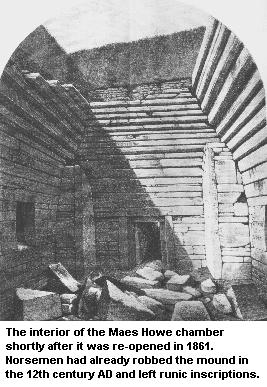
Maes Howe, Orkney
Maes Howe - a description of the chambered cairn called Maes Howe on Orkney and its passage orientation to the winter solstice sunset.
Stones
of Wonder
QUICK LINKS ...
HOME PAGE
INTRODUCTION
WATCHING
THE SUN, MOON AND STARS
THE
MONUMENTS
THE
PEOPLE AND THE SKY
BACKGROUND
ARCHAEOASTRONOMY
USING
THE SITE DESCRIPTION PAGES
VISITING
THE SITES
THE
LEY LINE MYSTERY
THE
SITES
ARGYLL
AND ARRAN
MID
AND SOUTH SCOTLAND
NORTH
AND NORTH-EAST SCOTLAND
WESTERN
ISLES AND MULL
Data
DATES
OF EQUINOXES AND SOLSTICES, 1997 to 2030 AD
DATES
OF MIDSUMMER AND MIDWINTER FULL MOONS, 1997 to 2030 AD
POSTSCRIPT
Individual
Site References
Bibliography
Links
to other relevant pages
Contact
me at : rpollock456@gmail.com
Chambered Cairn NR195570*
How to find : Travel 15km east from Kirkwall on the A965, and the cairn will come into sight on the right. The site is in state care, and the opening hours are restricted, especially in winter.
 Best
time of year to visit : Winter
solstice c. December 22nd. It would be worth visiting the mound for about
a week around the time of the solstice, as the sunset should be visible
from the chamber all during that period (given clear weather).
Best
time of year to visit : Winter
solstice c. December 22nd. It would be worth visiting the mound for about
a week around the time of the solstice, as the sunset should be visible
from the chamber all during that period (given clear weather).
This famous monument consists of a turf-covered mound over 7 metres high and 35 metres across, set on a level platform which is surrounded by an original ditch. (The wall outside the ditch is modern). Most of the mound beneath the covering of grass consists of clay and stones.
An entrance on the south-west side of the mound leads into a stone-built passage which is 1.4 metres high, and just under a metre wide. This passage runs straight inwards for over nine metres, and leads to a relatively high and spacious chamber in the middle of the mound measuring 4.5 x 4.5 metres. Vertical walls to head height are topped by oversailing sandstone blocks to create a corbelled vault. Each corner of the chamber has a buttress which serves to support the roofing.
There are three recesses or cells in the chamber walls, set at just above waist height. A large stone lies on the floor in front of each of the cells, and these are likely to have been used as blocking. The stones for the passage and chamber have been carefully selected and dressed, and fitted together with care and precision.
 Evidence from various excavations over the years has produced limited
information. The passage and chamber were cleared of debris in 1861, when
a fragment of human skull was found in one of the cells, along with some
possible horse bones and teeth. Two trenches were cut into the north-east
and south east areas of the ditch and mound in 1954-1955. Another cutting
was made in the ditch and platform in 1973-1974, which showed that the
surrounding ditch had originally been 2 metres deep.
Evidence from various excavations over the years has produced limited
information. The passage and chamber were cleared of debris in 1861, when
a fragment of human skull was found in one of the cells, along with some
possible horse bones and teeth. Two trenches were cut into the north-east
and south east areas of the ditch and mound in 1954-1955. Another cutting
was made in the ditch and platform in 1973-1974, which showed that the
surrounding ditch had originally been 2 metres deep.
Maeshowe was broken into from the top by a party of Vikings in the 12th century, and they left over twenty sets of runic inscriptions carved on the walls of the chamber to record their exploits, as well as a carved lion and a serpent.
Maeshowe has not been dated directly, but by association with the stone circle at Stenness nearby, and with the well known settlement site of Skara Brae on the west coast it is thought to have been erected about 3000BC.
 Our interest in the mound lies in the orientation of the passage. The
passage faces south-west, towards the position of the setting sun at midwinter¹.
The Historic Scotland guidebook² even features a photograph of this
event, with the beam of light striking the back wall of the side chamber.
Our interest in the mound lies in the orientation of the passage. The
passage faces south-west, towards the position of the setting sun at midwinter¹.
The Historic Scotland guidebook² even features a photograph of this
event, with the beam of light striking the back wall of the side chamber.
Just inside the entrance to the passage on the left side there is a recess built into the passage wall. This recess holds a large stone, which was found in the passage during the excavations of 1861. This stone may have been used by the builders of Maeshowe to block the front of the passage. The recess suggests that the blocking and unblocking of the mound could be carried out at will. The stone fits the width of the passage exactly, but leaves a strip above open to a height of 50cm. This feature is very reminiscent of the roof-box above the passage in the Neolithic mound of Newgrange in Co. Meath, which allows the light into the chamber at sunrise on midwinter's day³.

Photo of Maes Howe by kind permission of Sigurd Towrie. Find out more about Orkney and its history by visiting his Orkneyjar Website.
More information about the sun's appearance in the chamber of Maes Howe and some video are available here.